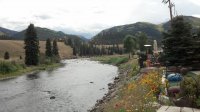- Posts: 2915
- Thank you received: 3
Himalayan Glaciers Not Melting because of Climate Change
- Grady
-
 Topic Author
Topic Author
- Mountain Legend
-

Himalayan glaciers are actually advancing rather than retreating, claims the first major study since a controversial UN report said they would be melted within quarter of a century.
Researchers have discovered that contrary to popular belief half of the ice flows in the Karakoram range of the mountains are actually growing rather than shrinking.
The discovery adds a new twist to the row over whether global warming is causing the world's highest mountain range to lose its ice cover.
It further challenges claims made in a 2007 report by the UN's Intergovernmental Panel on Climate Change that the glaciers would be gone by 2035.
Read about it here
Please Log in or Create an account to join the conversation.
- Nmysys
-

- Mountain Legend
-

- Posts: 4563
- Thank you received: 0
Please Log in or Create an account to join the conversation.
- pineinthegrass
-

- Mountain Legend
-

- Posts: 2836
- Thank you received: 25
But even from reading the article, it states that glaciers surrounded by tall mountains or covered with thick debris are not shrinking. Seems reasonable to me.
And those not surrounded by tall mountains or covered with thick debris are shrinking (retreating). So one might conclude that without tall mountain shadows or debris to protect them, they are responding more to increasing temperatures than the more sheltered glaciers. But I guess the author didn't think of that.
Please Log in or Create an account to join the conversation.
- Rockdoc
-

- Mountain Legend
-

pineinthegrass wrote: Well, the article is summarizing a study which it doesn't link. So for all we know the author of the article is picking and choosing from the study to support what he believes.
But even from reading the article, it states that glaciers surrounded by tall mountains or covered with thick debris are not shrinking. Seems reasonable to me.
And those not surrounded by tall mountains or covered with thick debris are shrinking (retreating). So one might conclude that without tall mountain shadows or debris to protect them, they are responding more to increasing temperatures than the more sheltered glaciers. But I guess the author didn't think of that.
Without reading the paper it is difficult to access what the author did and did not consider. Glaciers grow as a function of snowfall vs the rate of ablation (melting). Even if average temperatures are higher, glaciers can continue to grow if there is excessive snow at their head. Debris has an insulating affect. (Think of ice insulated by sawdust, the way the kept ice into the summer during the old days). The problem with debris is it's rocks, and those are not real good insulators, plus they tend to sink (melt) into the ice. Towering mountains produce sun shadows, so that helps keep cooler temperatures in local areas. Without a history of temperature measurements, drawing conclusions about climate change from alpine glacial ablation or growth rates is tenuous at best.
Please Log in or Create an account to join the conversation.
- Martin Ent Inc
-

- Mountain Legend
-

- Posts: 6540
- Thank you received: 0
Didn't see the whole thing so will have to catch it later.
Please Log in or Create an account to join the conversation.
- Rockdoc
-

- Mountain Legend
-

Martin Ent Inc wrote: Was watching a study done last year on the AK glaciers. Seems one has grown 300' deeper than when they conducted the last study.
Didn't see the whole thing so will have to catch it later.
This reminds me of an ecologic principle called disturbance. Disturbance my be physical or biologic in nature, but it's affect is to reduce species diversity. Scale plays an important role in this. Disturbance (eg. a hurricane wiping out a reef along the north side of Jamaica) obliterates all life, but such a disturbance is local in nature on a global scale. The relationship is that specific glaciers are like a local disturbance and do not reflect global climatic change. So even if there is an overall increase or decrease in average global temperature, it's affect may be ameliorated locally, meaning there are refuges (local conditions that allow certain glaciers to escape shrinking). Perhaps a better indicator of global warming is the slow but steady rise in sea level. Changes in sea level reflect a redistribution of water tied up in glaciers. Global sea level changes thus reflect global ablation of glaciers and ice fields that otherwise tie up water. Radio carbon dated mangrove peat (forms in the intertidal zone) occurs many feet below sea level today in Belize and the Bahamas. I do not have the plot in front of me, but it establishes the rate of sea level rise over the past 10,000 years. There is no doubt sea level is rising and that glaciers on a global scale are melting.
Please Log in or Create an account to join the conversation.
- archer
-

- Mountain Legend
-

- Posts: 9964
- Thank you received: 8
Please Log in or Create an account to join the conversation.
- The Viking
-

- Mountain Legend
-

- Posts: 9276
- Thank you received: 31
archer wrote: not unlike the observation that it has been colder and snowier than normal in the northeast United States this year, therefore global warming is a myth.
By jove, I think she's got it!!! :thumbsup:
Please Log in or Create an account to join the conversation.
- Rockdoc
-

- Mountain Legend
-

archer wrote: not unlike the observation that it has been colder and snowier than normal in the northeast United States this year, therefore global warming is a myth.
I do not see how you can conclude that global warming is a myth? Weather in NE is a local phenomena and not an absolute reflection of global climate. In effect it is a local disturbance and perturbation associated with global changes. You are going to see all kinds of weather patters that seem to be inconsistent with the long term trend because such weather patterns represent short term cycles, whereas the progressive sea level rise recorded in mangrove peat distributions relative to present day sea level clearly indicate the globe is converting ice water to liquid water.
What is a myth in my mind is man's CO2 emissions as the cause of global warming.
Please Log in or Create an account to join the conversation.
- archer
-

- Mountain Legend
-

- Posts: 9964
- Thank you received: 8
We hear it every winter....gee, it's cold today....where is the global warming? Those that think one observation from one point on the globe disproves the theory of global warming should have flunked every science class they ever took.
Please Log in or Create an account to join the conversation.





